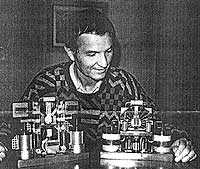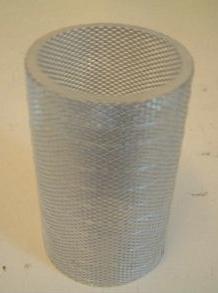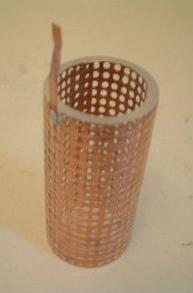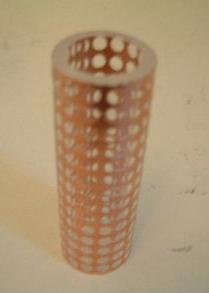For each of the two small testatika units and the 50cm disk unit there are two canisters, frequently refered to as pots. The contents of these pots are largely unkown. The only person reported to have seen inside was Stefan Marinov and he saw inside only the pots for one of the small units. He said the following:
|
The capacitors have a cylindrical "grid", cylindrical plastic insulation and a copper spiral in the center... THAT'S ALL! I saw in one of the small machines and there are no magnets. - Stefan Marinov 9/4/90 |
|
Further evidence of the presence of grids comes from the report from the visit of 30 engineers to the Methernitha community where near the bottom of the report, the following is said of the 50cm disk unit (the 3kW machine): "In the large capacitors there are 20 layers of perforated sheet (Baumann said)".
For my various tests I of course needed pots, and I wished to make mine as close to what Stefan Marinov said he saw inside them, namely one or more grids, spaced apart by clear plastic cylinders and with a loose coil of thick wire with a few turns in the middle. I also wanted to make the spacing as precise as I could and the components changable. Note that what is actually used in any one experiment will vary but this will give you an idea of how they can be built.
Construction of the Pots
Amazingly, I happened to find a store that had clear acrylic cylinders of the diameters I needed based on my measurements of the small machine from pictures. The heights of all cylinders are 80mm. The remaining diameters are as in the following table.
| Description | Inner diameter | Outer diameter |
|---|---|---|
| The outer cylinder which will not have any electrode around it. | 50mm | 57mm |
| The next cylinder in will have an aluminum grid electrode wrapped around it. | 41mm | 47mm |
| The next cylinder in will be the output cylinder and will have a copper grid electrode wrapped around it. | 31mm | 38mm |
| The last cylinder may not be used. | 19mm | 26mm |
|
|
| ||
|
|
|
|
|
|
|
|
| ||
|
|
|
|
|
|
|
| ||
|
|
|





